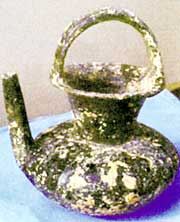Archeology / The use of cocoa began 1,000 years earlier than previously thought
Yanai Ofran

The clay kettle in which the Maya frothed cocoa. Totally different taste. Photo: Economist
The relationship between man and chocolate began 1,000 years earlier than was commonly thought until now, according to a study published this week.
Chocolate arrived in Europe only in the 16th century, after the conquistadors learned from the Aztecs and the Maya how to make chocolate. Very little is known about the pre-classical history (prior to 250 AD) of the Native American tribes, and even less is known about their culinary history. That is why it is very difficult to determine exactly when man discovered chocolate. The Spanish wrote about the Maya's love of chocolate, who used to mix cocoa with almost everything - from corn and honey to chili. The highlight of the Indian chocolate industry was the chocolate drink. Testimonies of the Spanish conquerors tell of a foamy chocolate drink that the Maya especially like. But all this evidence is of course late.
About 20 years ago, archaeologists discovered remains of chocolate in vessels dated to the fifth century. This was the earliest evidence of the use of the cocoa plant for food production, and thus it was determined that the beginning of the history of chocolate is at the latest around the year 400 In addition to articles written by researchers in academia, the journal "Nature" sometimes also publishes articles by researchers from industry. Usually these are the senior executives of the research and development departments of the pharmaceutical or electronics companies, who report revolutionary findings that can lead to new products. But this week the prestigious British journal publishes the findings of the American chocolate grant researcher "Hershey".
Geoffrey Hurst, of the Hershey Technical Center, reports using new methods to try to locate chocolate in older vessels. He was aided by a 2,600-year-old clay kettle found at a burial site of Mayan nobles in the Belize region. At his request, the archaeologists sent him half a gram of the grayish pulp that covered the inside of the kettle. Hearst tried to determine if this sample also contained remains of the cocoa plant. He used a combination of innovative chemical methods to identify the unique chemical components of cocoa. All these ingredients were found in the dusty pulp scraped from the sides of the ancient vessel.
What was this kettle used for? Hurst hypothesizes that the Mayans used such kettles to make the foamed chocolate. The chocolate was poured from one kettle to another and back, again and again, until foam was obtained.
Was Hershey secretly working on research that would decipher the Indian chocolate recipes?
Hearst vehemently denies. We did it for fun, he told the BBC. The Indian recipes, he claims, are very far from "the taste we have settled on today". Since the Spanish brought cocoa to Europe, the recipes have been adapted to the Western palate. What worries Hershey is of course how to get modern Americans to consume more chocolate and not what the natives liked three thousand years ago. Chocolate consumption per capita in America (5 kg per year) is not particularly high if you compare it to the 10 kg that the Swiss consume, although it is still more impressive than the three Israeli kilograms. It seems that the Maya, like their southern neighbors the Aztecs, did not insist on the sweetness of chocolate. There is also no evidence of mixing the cocoa with milk. "If you want to get an idea of the taste of Mayan recipes, take a blender and mix cocoa, water and spices in it. It's not something I really want to taste," Hurst concludes.
